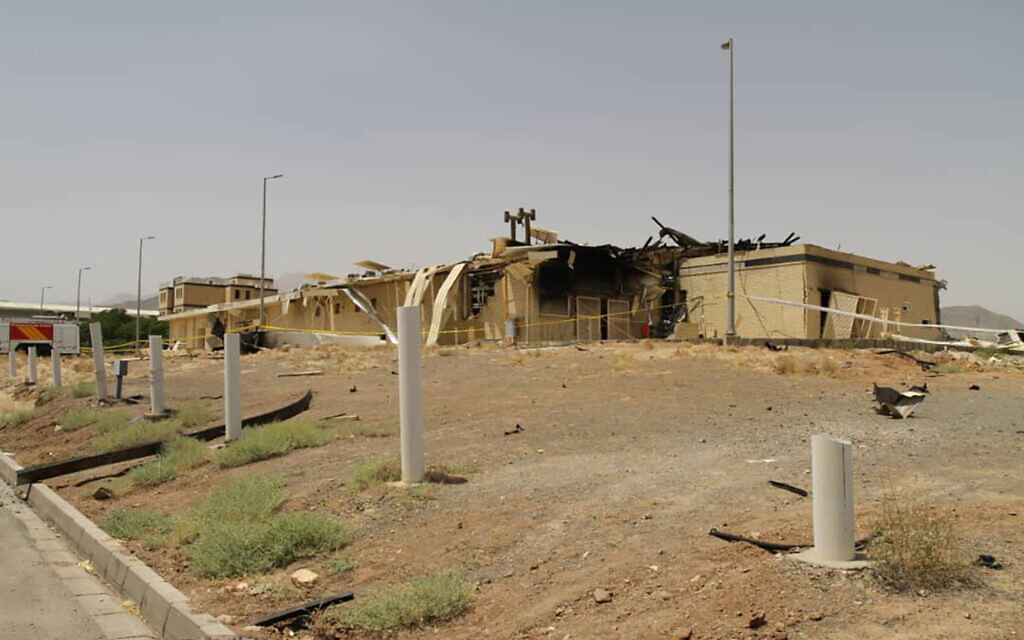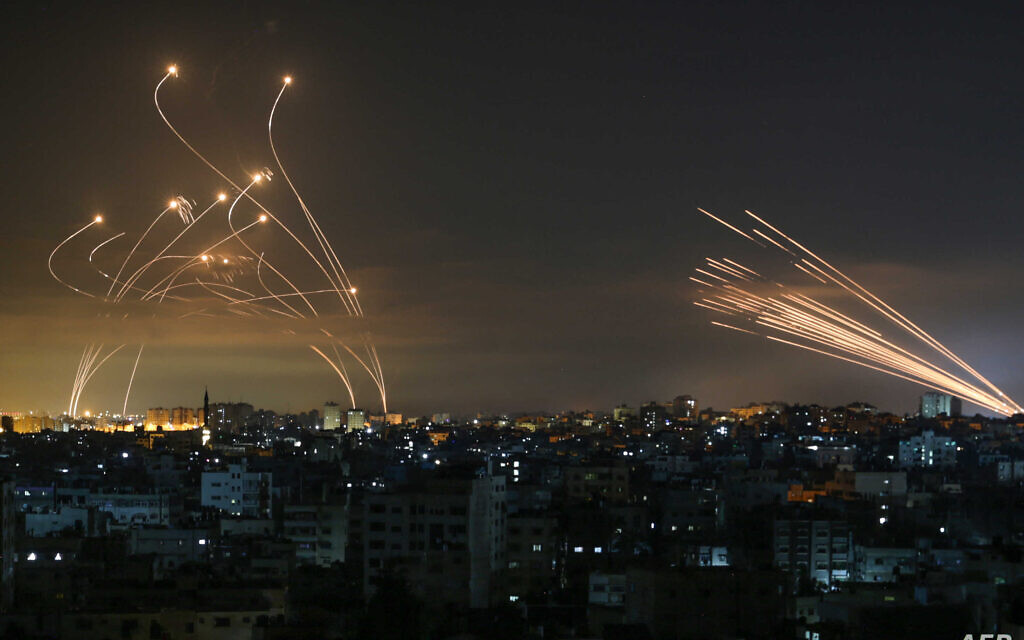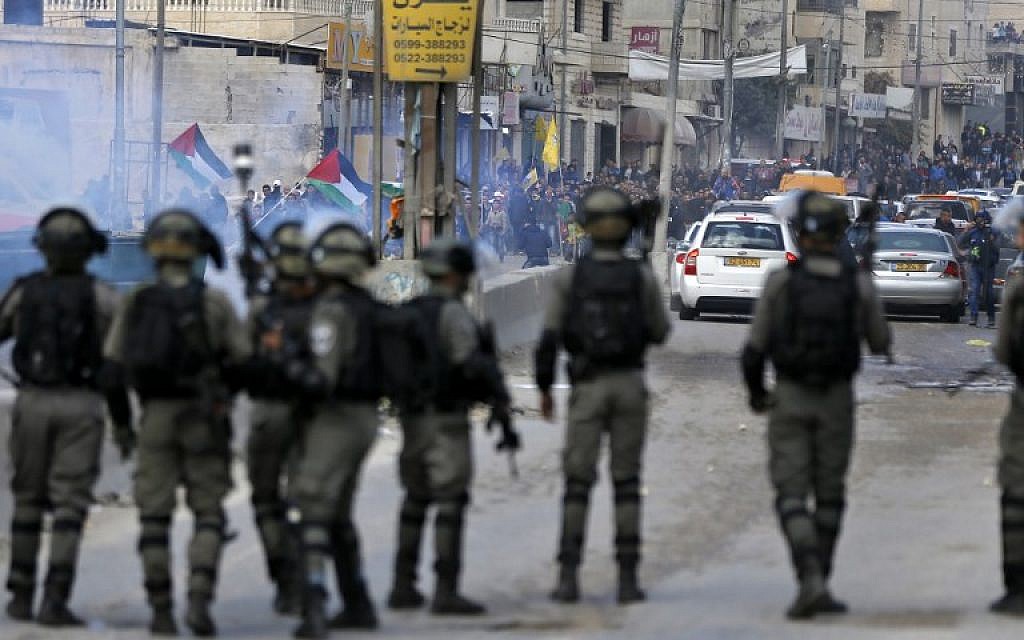The Israel Defense Forces believes it significantly curbed Iran’s ability to transfer weapons and equipment through Syria over the past year through its airstrikes, and plans to continue doing so in 2022, The Times of Israel has learned.
The military hopes that these attacks will also drive a wedge between Syrian dictator Bashar Assad and Tehran.
At the same time, the military is pressing ahead with its preparations for a potential strike on Iran’s nuclear facilities, amid ongoing talks in Vienna between Tehran and world powers on a return to the 2015 accord to halt the Islamic Republic’s nuclear program in exchange for sanctions relief.
While efforts to develop what Israeli officials refer to as a “credible military threat” against Iran’s program are continuing apace, and despite at-times bellicose rhetoric from Israeli politicians and IDF officers, it remains entirely unclear if Israel would indeed carry out such a strike even if Iran were on the verge of developing a nuclear weapon: Such an attack would almost surely prompt large-scale retaliation by Iran directly and through its proxies in the region, potentially plunging Israel into a massive, devastating multi-front war.
The decision on how to proceed will ultimately depend on a variety of factors, from the degree of American support for such an operation to the level of readiness of Israeli air defenses and bomb shelters — and, perhaps most critically, the extent to which the IDF believes its attack would actually set back Iran’s nuclear program. Under certain circumstances, the military believes that the cost of such an operation could outweigh its benefit to Israel’s national security.
In addition to preparing to counter the larger, regional threats, the IDF also expects to dedicate considerable resources in the coming year to countering Hamas in the Gaza Strip, despite the currently holding ceasefire with the terror group following May’s 11-day conflict; and to fighting terrorist activity in the West Bank, which has seen a significant rise in violence recently, of both Palestinian attacks against Israelis and Israeli settler attacks on Palestinians, according to IDF statistics.
While the past year has so far matched 2020’s record low for the number of Israelis killed in terror attacks emanating from the West Bank, with three victims as of Tuesday, this is offset by the large number of people in Israel killed by attacks from the Gaza Strip, with 13 killed from the fighting in May (12 of them civilians), and a Border Police officer shot dead during a riot at the Gaza security fence in August.
Some of the victims of the Gaza rocket fire: Top row (L) Omer Tabib (R) Ido Avigal; 2nd row (L) Leah Yom-Tov (R) Soumya Santosh; 3rd row (L) Nadeen Awwad (R) Khalil Awwad; 4th row (R) Nela Gurvitch (L). Ramat Gan after the rocket strike (Oren ZIV / AFP)
Overall, the IDF sees a positive trajectory for Israeli security in the coming year. The military believes that most of the country’s enemies are deterred from initiating a large-scale conflict against Israel. Jerusalem’s growing ties with countries in the Middle East, from new public allies like the United Arab Emirates and Bahrain to more established partners like Jordan and Egypt, provide Israel with a greater ability to operate in the wider region. And, after years without one, the country’s newly passed budget gives the IDF the resources necessary to negotiate long-term agreements with defense contractors in the US and at home in order to ensure that the military will have the weapons and systems that it needs for years to come.
Supply chain disruptions
According to military estimates, Iran has been unable to transfer its weapons systems through the region — either by air, sea or land — roughly 70 percent of the time, thanks to Israeli intervention, and its ability to do so is limited the rest of the time. As a result, the number of advanced or strategic weapons systems in Syria is decreasing, the IDF believes.
“The increase in the number of operations in the past year caused significant disruption to all pathways of injecting weaponry to different fronts by our enemies,” IDF Chief of Staff Aviv Kohavi told reporters this week, as part of a year-end briefing.
Over the past year, the IDF has conducted dozens of airstrikes on targets in Syria using hundreds of bombs, a slight increase in the number of operations from 2020 and nearly twice as many as in 2019.
Most recently, Syria accused Israel of conducting a rare strike Tuesday against the country’s port in Latakia, an area that until this month Israel had refrained from attacking due to the presence of Russian forces nearby. It was the second such attack on the port in the past month, likely indicating Moscow had signed off to some extent on these operations.
The IDF does not believe it will ever fully block Iran’s efforts to transfer advanced weaponry to its proxies, but it hopes to limit it as much as possible. In addition to its direct strikes on Iranian weapons caches and against Iranian-linked facilities in Syria, the IDF is also looking to exact a price from Damascus for permitting Iran to operate in the country, in a bid to convince Assad to halt, or at least scale back, this support. This effort is seen in the IDF’s strikes on Syrian air defenses and against bases of Syrian military units that cooperate with Iran’s Islamic Revolutionary Guard Corps.
Over a decade after the outbreak of Syria’s civil war, Assad currently controls roughly two-thirds of the country, with the rest being held by Syrian rebels, Kurdish forces, Turkey or the United States (in the case of the Tanf region in eastern Syria).
As Assad looks to reestablish his sovereignty over his portion of the country, the IDF hopes that he will begin opposing Iranian activities there to a certain extent, though he is unlikely to fully expel the Iranian-supported militias that have supported him for the past 10 years.
While Israel would like to to have all Iranian-backed forces out of Syria, it is most concerned about their presence and the presence of Hezbollah troops along the Golan border, and has focused considerable efforts on driving them away, conducting strikes against their positions and those of Syrian units that allow them there, as well as publicly outing the commanders involved.
While Hezbollah forces remain on the border, the IDF believes that its operations have prevented the terror group from deploying the amount of troops and weaponry on the frontier that it had planned.
Preparing for a strike that may never occur
The IDF will continue its preparations for a strike against Iranian nuclear facilities in the coming year, with plans to hold an exercise in the spring to simulate such an attack and ongoing efforts to obtain the munitions needed for the mission.
While the IDF believes that it could take some form of military action against Iran’s nuclear program at short notice, this would likely have a limited effect.
Currently, for instance, the IDF has the ability to bomb Iran’s Natanz enrichment site, an easier target as even its underground portions are located close enough to the surface for standard munitions to hit. However, the Fordo site, which is buried deep underground beneath a mountain of rock, would be far more difficult to strike without the use of powerful and extremely heavy bunker-buster type bombs that Israel does not necessarily have the capability to carry.
It would take at least several months and likely over a year to develop the capabilities to conduct a more comprehensive strike that would set back Iran’s nuclear program by several years. Though such an attack is also meant to have a deterrent effect against future enrichment, even the most comprehensive strike would only delay the nuclear program, as the technical knowledge and experience that Iranian scientists have already amassed would not be lost.

A building Iran claims was damaged by a fire at the Natanz uranium enrichment facility some 200 miles (322 kilometers) south of Tehran, on July 2, 2020. (Atomic Energy Organization of Iran via AP)
The newly passed national budget, which included a significant boost to defense spending — some of it specifically allocated toward preparing for such a strike — has allowed the military to press forward with these efforts, purchasing not only the munitions needed for an attack but also for strengthening the air defense systems that would be critical in defending the country from the expected retaliation.
“The IDF’s force build-up plan has advanced significantly, at an accelerated pace in the past year,” Kohavi said this week. “At the center of this has been a notable improvement in the number of identified enemy targets and in intelligence; the completion of deals to significantly increase the number of bombs and interceptor missiles; advancement of the plans for a nationwide air defense network; and improvements to communication systems.”
Closer to home
Just over six months after the IDF and Palestinian terror groups in the Gaza Strip fought a punishing 11-day conflict, the military notes that very few rockets have been fired at Israel since the fighting ended in late May: just five rockets in the past six months, compared to the 22 that were fired in the six months after 2014’s Gaza war.
The IDF credits this calm to two factors: first, the government’s civil policies toward Gaza that have slowly allowed the beleaguered, financially depressed enclave to rebuild; and second, the military’s threats of harsh retaliation to attacks from the Strip, which it demonstrated in the months following the conflict by dropping some 80 tons of bombs on Hamas facilities in response to the few rocket and airborne arson attacks.

Rockets from Gaza, on right, are seen in the night sky fired toward Israel from Beit Lahia in the northern Gaza Strip on May 14, 2021, while Iron Dome interceptor missiles, on left, rise to meet them. (Anas Baba/AFP)
At the same time, the military found a number of areas in which it struggled during the May conflict, known in Israel as Operation Guardian of the Walls: notably in preventing Hamas and Palestinian Islamic Jihad from firing rockets at the Israeli home front. While roughly 90 percent of the rockets heading toward civilian areas were intercepted, the large volume of projectiles that were fired meant that many did get through. The IDF says it has improved its ability to locate launch sites and destroy them during fighting, bit it remains an area of concern for the military. And a specialized team was created within the IDF General Staff to address this issue, developing new technologies and tactics to counter the threat.
The West Bank remains a major source of concern for the IDF. The past year saw a significant rise in violence there, with twice as many shooting and stabbing attacks reported in 2021 compared to the year before, (61 and 18 respectively, as opposed to 31 and nine in 2020). There was also a nearly 40% increase in the number of documented rock-throwings and 33% more firebombings, according to IDF statistics.

Border Police officers take aim at Palestinian rioters during clashes near the West Bank Qalandiya checkpoint, on the outskirts of Ramallah, on December 15, 2017. (Abbas Momani/AFP)
The military credits much of this rise to the higher levels of violence that were also seen in the West Bank during Operation Guardian of the Walls, but some of it is also a result of more recent unrest. Since the fall, with the annual olive harvest, the IDF has found a noted increase in violence by Israeli extremists against Palestinians — and in some cases against Israeli security forces — alongside a rise in Palestinian violence against Israeli settlers.
The IDF has been criticized for routinely failing to prevent Israeli attacks against Palestinians. Though IDF officials acknowledge that soldiers could do more on this front, the military generally prefers that the Israel Police lead this effort.